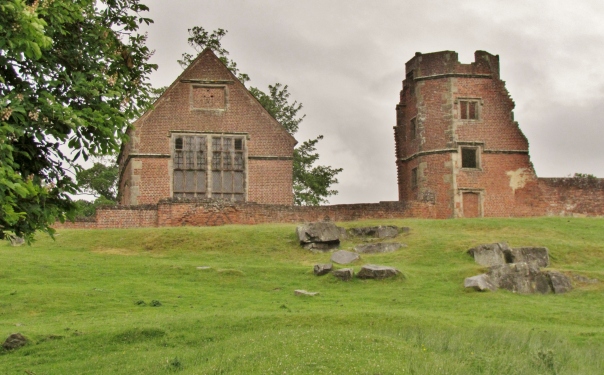The ruins of Bradgate House are to be found in the grounds of Bradgate Park, a few miles north-west of Leicester. Who might have lived here?
The mansion was completed in 1520, and was one of the first great unfortified country houses in England. It was also one of the first buildings since Roman times to be built using brick.
Twenty years after it was built, it was the childhood home of Lady Jane Grey.
A brief history of Lady Jane Grey
Jane was born, probably in Bradgate House, in 1536 or 1537. She lived there until she was nine, when she was sent to live with Thomas Seymour (the brother of Jane Seymour). This was during the last months of the reign of Henry VIII; the King was dying, and his son, Edward, was only nine years old. Seymour was set to become part of the Regency Council that would govern the country until Edward VI was old enough to rule in his own right. It is likely that Seymour intended to promote Lady Jane as a royal bride for Edward.
The marriage did not happen, and in 1553, Jane was married to Lord Guildford Dudley, the son of the Duke of Northumberland. The Duke of Northumberland had become the leading figure in the Regency Council, and was extremely powerful. He was able to exert much influence over the King.
During the reign of Edward VI, Protestantism became more firmly embedded as the state religion. In 1553, it became clear that Edward was dying, and the most obvious successor was his sister Mary, a staunch Catholic. At this point, Edward wrote a document to change the succession, so that his sisters Mary and Elizabeth would be overlooked, and Lady Jane Grey, the eldest daughter of his niece, would succeed him. In changing the succession, Edward was acting in a similar way that his father had done in 1533 and 1536. However, the Third Act of Succession had been passed in 1543, and Edward had no right to do so, except by another Act of Parliament.
On 6th July, 1553, Edward VI died, and on 10th July, Lady Jane Grey was proclaimed queen by Northumberland and the Privy Council. She was initially reluctant, before being cajoled into submission:
If what hath been given to me is lawfully mine, may Thy Divine Majesty grant me such spirit and grace that I may govern to Thy glory and service, to the advantage of this realm.
Lady Mary, who had been staying in Hertfordshire when she heard of Edward’s death, fled to her stronghold in East Anglia. Northumberland set out from London on 14th July with 3000 troops to capture her. Mary moved to Framlingham Castle in Suffolk, and was quickly gaining support.
In the end, no battle was needed. As Mary gathered support, Northumberland’s army began to desert. The Privy Council, realising the way the wind was blowing, hastily changed sides and proclaimed Mary queen on 19th July. Queen Jane’s nine-day rule was over.
Queen Mary entered London on 3rd August, and Northumberland was executed two weks later. Jane and her husband were also sentenced to death, although there is evidence that Mary intended to commute the sentences. Only when Jane’s father and brother became involved in a subsequent plot against Queen Mary, did the sentences get carried out. Lady Jane Grey was beheaded on Tower Hill on 12th February, 1554.

Bradgate House
The above picture shows the Chapel of Bradgate House, and the eastern tower, known as Lady Jane’s Tower. Below, we see the wall of the Great Hall, viewed firstly from what would have been the kitchens, then from the chapel. The largest window in the wall was extended later to create a bay, in preparation for a visit by William III in 1696. Some of the smaller walls in the foreground would have formed part of the original cellars.
Why visit?
Bradgate House is an important part of Bradgate Park, but it is not the only attraction. The park contains many paths through the bracken and heather, and the River Lin flows through it on its way to Cropston Reservoir.
Geologically, Bradgate park contains some of the oldest rocks in England, formed when volcanic eruptions deposited layers of ash on the ocean floor some 600 million years ago. Within these rocks have been found precambrian fossils – Charnia masoni – which, at 570 million years old, is one of the oldest fossils in the world (pictured below). Although it has the appearance of a fern, it cannot be a plant since it existed in water too deep for photosynthesis to take place.
There are also other places of historical interest in Bradgate Park. These include Old John, an eighteenth century folly, and Queen Adelaide’s Oak, where the widow of William IV once picnicked. I shall return to Bradgate Park in later posts.
For most visitors, though, the main attractions of Bradgate Park are the open spaces, the numerous paths, and the free-roaming deer.
Getting there
Bradgate Park has three car parks. The nearest to Bradgate House, and the most suitable entrance suitable for wheelchairs, is at the western end, next to the church in the village of Newtown Linford. Newtown Linford is about six miles north-west of Leicester, and conveniently situated about two miles from J22 of the M1. Follow signs to Leicester, and after a mile, Newtown Linford is signposted to the left.
To the west of the park is Hallgates car park, while to the north is Hunts Hill car park. All three car parks are open from 7.45 am to dusk every day of the year. Although the car parks are closed, there are several public footpaths which cross-cross the park, meaning that the park itself is effectively always open.
There are public toilets at each of the car parks, and at the visitor centre near the Bradgate House ruins. Refreshments are available at the Newtown Linford car park, and at the visitor centre. There are also two pubs and several cafes in Newtown Linford.







